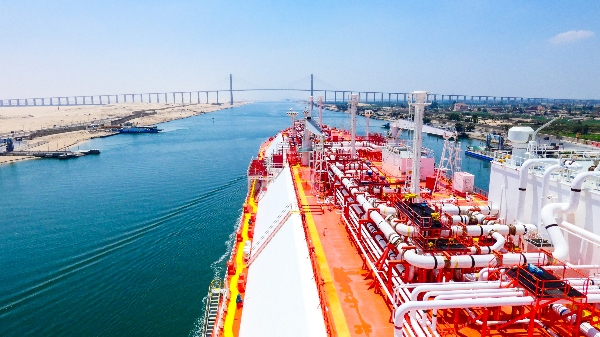Suez Ship Congestion Could Delay LNG Deliveries to Europe
LONDON (Reuters) — A container ship blocking the Suez Canal, one the world's busiest trade routes, could delay delivery of millions of tons of LNG to Europe if the vessel stays stuck there for two weeks, analysts said.

The giant ship ran aground on Tuesday. The Suez Canal stepped up efforts on Friday to free the ship and end a blockage on the main route for European imports of LNG from the Middle East and for some cargoes heading to Asia from the Mediterranean.
There are now six LNG vessels waiting to enter the canal, with four of them at the southern Red Sea end and two in the Mediterranean, according to data intelligence firm Kpler. A seventh ship is already in the canal, the data showed.
Six of these vessels are carrying a combined total of 500,000 tons.
A further 16 LNG vessels could have transit plans changed by Sunday if congestion persists and ships are not rerouted, the data showed. An additional 15 LNG vessels could arrive by Monday.
LNG tankers can have a capacity of up to about 260,000 tons.
Due to congestion, considerable delays are expected to the LNG loading schedule at Qatar's Ras Laffan.
Qatar, a major producer, shipped close to 260 LNG cargoes to Europe in 2020 via the canal, consultancy Rystad Energy said.
"Even if the route is liberated within one week, there is a large queue of cargoes lining up to cross the canal," said Carlos Torres Diaz, Rystad's head of gas and power markets. "The return to normal flow will take some time."
"It could be a perfect opportunity for U.S. producers to secure some orders at a time of such a transport route crisis," he added.
PRICE RISE
The average LNG price for May delivery into Northeast Asia has risen to $6.80 per million British thermal units (mmBtu) this week, up 25 cents from the previous week.
European gas prices have also risen.
Europe has passed its winter peak demand season and can also get pipeline gas from Russia and Norway, as well as LNG from Russia which does not need to go through the canal. But Qatari LNG is much cheaper than other sources.
Gas storage inventories for the time of year are at record lows and buyers have been keen to restock recently, given a deluge of LNG cargoes to European terminals.
LNG shippers may have to reverse course and travel around the Cape of Good Hope, or wait in the Red Sea and Mediterranean for the stranded container ship Ever Given to be refloated.
The voyage from Suez to northwest Europe takes around nine days at average speeds, Rystad said. The trip from Qatar to northwest Europe takes around 17 days, but rerouting around the Cape of Good Hope would take more than 30 days.
During winter in the northern hemisphere, when heating demand grows, congestion at the Panama Canal helped send spot LNG prices in Asia to record levels as shippers were forced to seek longer, more expensive routes.
Deliveries of LNG to Spain's seven regasification terminals have not yet been disrupted, a spokesman for system operator Enagas said.
Enagas said 9% of Spain’s LNG comes through the canal.
"No LNG ship bound for Spain has been affected by the ship stuck in the Suez Canal, and there are no ships scheduled to come from countries that use this route in the next two weeks," the Enagas spokesman said.
Related News
Related News

- Enbridge Plans 86-Mile Pipeline Expansion, Bringing 850 Workers to Northern B.C.
- Intensity, Rainbow Energy to Build 344-Mile Gas Pipeline Across North Dakota
- U.S. Moves to Block Enterprise Products’ Exports to China Over Security Risk
- 208-Mile Mississippi-to-Alabama Gas Pipeline Moves Into FERC Review
- Court Ruling Allows MVP’s $500 Million Southgate Pipeline Extension to Proceed
- U.S. Pipeline Expansion to Add 99 Bcf/d, Mostly for LNG Export, Report Finds
- A Systematic Approach To Ensuring Pipeline Integrity
- 275-Mile Texas-to-Oklahoma Gas Pipeline Enters Open Season
- LNG Canada Start-Up Fails to Lift Gas Prices Amid Supply Glut
- Kinder Morgan Gas Volumes Climb as Power, LNG Demand Boost Pipeline Business




Comments